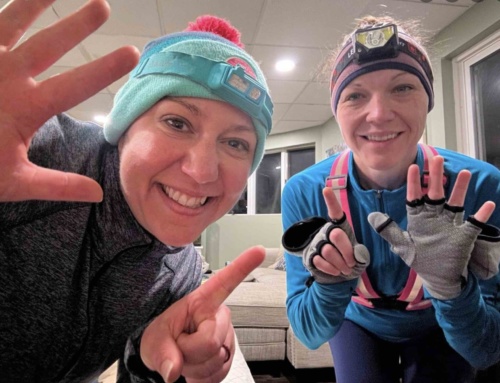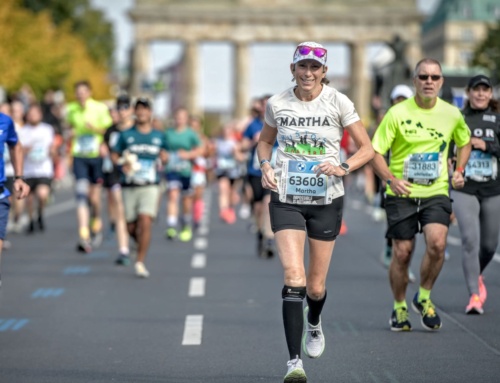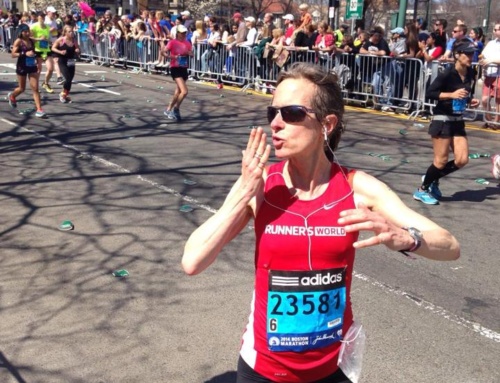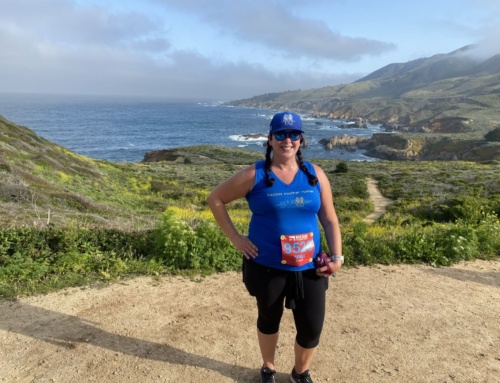
Heidi (in sunglasses) running in the Charlottesville Women’s 4 Miler on Aug 31 (17 days after her last dose of chemo!) with her daughter Grace and her nephew’s fiance.
During this week, our Motherlode of Miles week that benefits the Donna Foundation, we are profiling four #motherrunners whose lives have been changed by breast cancer; hopefully the perspective and ideas they share will benefit others who are going through similar situations.
We’re starting with Heidi Gillenwater from Charlottesville, Virginia, who has four kids (ages 23, 20, 15, and 13.)
These posts are in their own words; they will also be guests on the AMR podcast at the end of this week.
Date of diagnosis: March 4, 2019
Type of breast cancer: Stage 2, invasive infiltrating ductal carcinoma, ER/PR positive, HER2 negative
Running through it: My treatment started with surgery: lumpectomy on April 4, 2019. I took 2 weeks off from running completely after surgery. I eased back into running again after this 2-week break but then had to take another little break when I got my porta cath.
I did my first post-chemo run two days after my first chemo. I continued to run throughout my chemotherapy treatment which started May 8 and ended Aug 14. (I received dose-dense adriamycin and cytoxan every 2 weeks for 4 cycles, then taxol every 2 weeks x 4 cycles.)
The thing that I noticed most with running while on receiving chemotherapy was that my heart rate became elevated out of proportion to my perceived level of exertion. For example, the run felt easy, but before I knew it, my heart rate was in the high 160’s or 170’s. This was very unusual for me.
Because of this, I used heart rate as my guide rather than perceived effort. I completely forgot about pace. I managed this by running until I noticed my heart rate drift into the high 150’s or low 160’s and then I would take a walk break until I recovered into the 130’s again.
I noticed that later in the cycle (when I was getting closer to being due for another cycle of chemo) I was able to run for longer stretches without walking.
I know that there are probably a lot of reasons for these observations with my running. Some are likely just deconditioning due to the break required after surgery. But I also got progressively more anemic with each cycle of chemo. And I know that the chemo was messing with all of my cells, not just the potential cancer cells that may be trying to lurk in the corners.
I started radiation on Sept 9. I am now able run continuously without my heart rate elevating into the 160’s. I am starting to gradually increase my mileage again and this feels so good.
Throughout all of this time, I have been going to a local treadmill studio where are there are different workouts that incorporate running and strength. After recovering completely from surgery, I felt that I had no limitations with strength work, and because of that, I feel that I have never been stronger. I have some serious strong glutes now.

Heidi and her family, just before her chemo started.
How breast cancer changed her running perspective: Although I have been running for a long time, probably over 30 years, I have been laser-focused on trying to qualify for Boston for the past six years. Through this process of trying to be the best runner I could be I learned a lot of things.
I learned that to get the most out of training, there must be a careful balance of focused high quality running, easy running, good nutrition, and self-care that includes quality sleep and general stress management. I needed every bit of these past six years to learn this.
I was registered to run the Sugarloaf Marathon in May of this year when I was diagnosed with breast cancer. I could feel deep in my soul that my body was finally really responding to all of the training and I was getting faster. My initial reaction to the timing of my breast cancer diagnosis was that it seems so unfair. I was very angry.
When I got over those emotions though I realized that these skills—nutrition, sleep, stress management, listening to my body—that took me six years to learn were exactly the skills that I needed to put my body in the best state to benefit from my treatment.
Who knew that I was not really training to be a better runner, but actually to be the best patient I could be?
Best thing she did for herself during treatment: Meditation has become a daily ritual. I have been using Headspace mostly, but occasionally I am able to meditate without guidance. Today my headspace app told me that I have meditated 100 days in a row. But I have really only missed probably 5-6 days since my diagnosis.
Best thing her friends/family did during treatment: Honestly, my biggest fear around having this diagnosis was being perceived by others as being sick. I don’t feel sick, and don’t want to be treated as if I am not well. I have appreciated every who treats me the same that they always did.
I just started publishing a public blog. This is something that has been sitting on my laptop until I had more courage (and time) to get it out there. I plan to include more details about my experience with exercise while on treatment as well as summarizing data from studies that have studied exercise in cancer patients while on treatment.






Hello! I was diagnosis with breast cancer at the end of July of this year. I had a lumpectomy on Aug 28 and a port put in on Sept 17. I ran Akron 1/2 on Sept 28 which was suppose to be my second full marathon but I dropped down to a half. I start my chemo this coming Friday, Oct. 4. I’m scared about the unknown but was wondering how chemo will effect my running. After reading your story, I think I’ll do just fine. Thanks for sharing!
I was just recently diagnosed with breast cancer and haven’t started treatment yet. It’s the HER2+ one and also involves the lymphnodes. I will be taking chemo prior to surgery for 3mos. I agree that everything I learned in training for marathons and triathlons will help make me face this
with a strong attitude (once I get over or learn to deal with the immense FEAR). I know I need to practice mantra’s and intentions. I’m open to learning about meditation. Thank you for sharing your positive experience.
One thing I want to point out is that this is Heidi’s journey. Others should not feel that because she was successful at continuing to run through her chemo and radiation and surgery, that they should as well. Each person’s reaction to cancer treatment is going to different, each person’s protocol is different.
As a runner, I was expecting to be able to at least walk my way through chemo. A friend had done so successfully and I was more of a runner/walker than she was, so I thought I would be fine. Well, I set myself up for failure with that thinking. I had a very different protocol than she did, and a very different reaction. When I expected to be feeling well enough to get out walking, I actually felt worse. Than I became disappointed in myself that I was not as “strong” as my friend. It turned out, my protocol was much harsher and I was having a more extreme reaction to it. The first week after treatment, I felt horrible and could not eat, the second week I had severe diarrhea and could not leave the bathroom (funny story about one time I did try to), but the third week I felt much better and was able to eat and get out and walk. This went on for each cycle until the protocol proved to be too taxing on my body so I had to switch protocols. The new protocol was so much easier on my body, that I had none of the extreme side effects and was out walking every day.
This is just to point out that even in the same person, different protocols had different outcomes. Imagine different people on different protocols?!
Please don’t judge your ability to walk/run based on someone else’s. Give yourself time to learn how your body will react to your protocol and then do what is best for you.
Hi Ilene! I was Her2+ also and I’m a 3-year survivor. I’m happy to talk to you about treatment and answer any questions if you would like! I did Herceptin + Perjeta + Chemo for 6 treatments, then Herceptin for the rest of the year, then Noratnib for a year. Double Mastectomy. No radiation, thankfully. My email is katie@anothermotherrunner.com.
I am a 2 1/2 yr survivor of stage 2, ER/PR + and ER2- cancer. Also did DD AC x4 and DD Taxol x4 and 33 rounds of rads. It’s a long road but here to tell you life after cancer is pretty darn good. Still running and very grateful. For all you gals just starting or just finishing… keep on keeping on!!